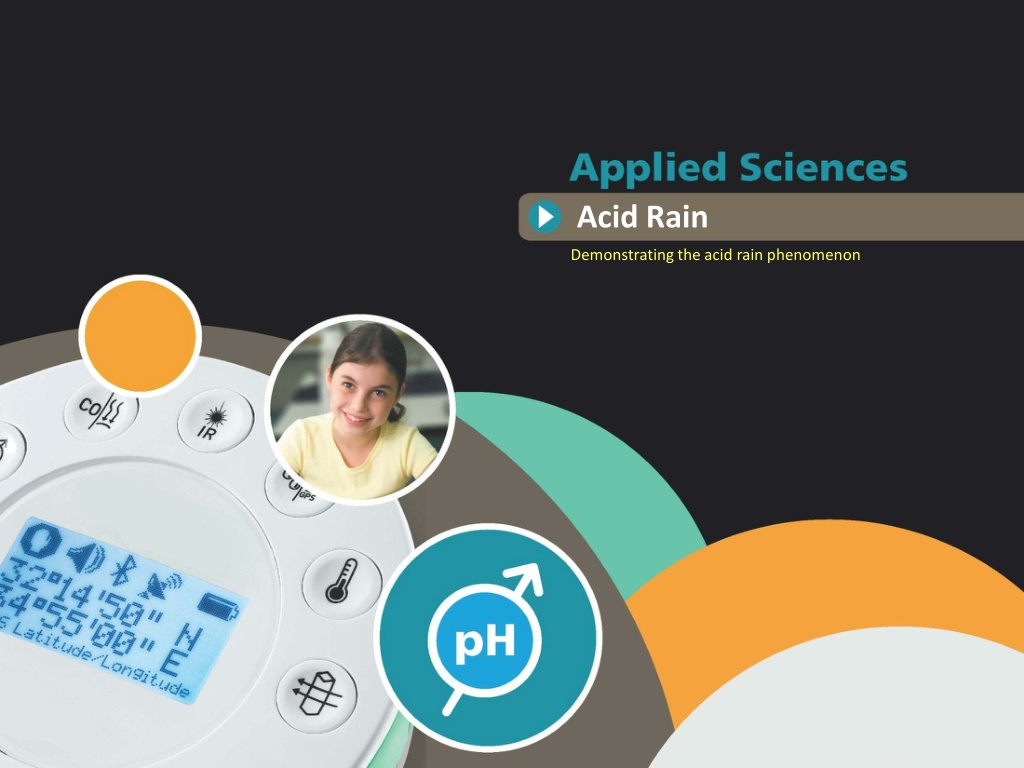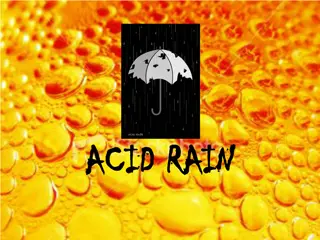The Impact of Acid Rain on Ecosystems
Investigate the effects of acid rain caused by fossil fuel combustion on water acidity, plant life, animals, and structures. Learn how nitrogen oxides and sulfur dioxide create acid solutions in the atmosphere, affecting watersheds and sensitive ecosystems. Explore the devastating consequences of acid rain on forests, aquatic life, and cultural heritage sites.
Download Presentation

Please find below an Image/Link to download the presentation.
The content on the website is provided AS IS for your information and personal use only. It may not be sold, licensed, or shared on other websites without obtaining consent from the author.If you encounter any issues during the download, it is possible that the publisher has removed the file from their server.
You are allowed to download the files provided on this website for personal or commercial use, subject to the condition that they are used lawfully. All files are the property of their respective owners.
The content on the website is provided AS IS for your information and personal use only. It may not be sold, licensed, or shared on other websites without obtaining consent from the author.
E N D
Presentation Transcript
Acid Rain Demonstrating the acid rain phenomenon
Acid Rain Demonstrating the acid rain phenomenon Objective The purpose of this activity is to investigate the effect of acid rain forerunner on water acidity, create a hypothesis and proceed to test it using the Labidsc pH-meter sensor.
Acid Rain Demonstrating the acid rain phenomenon Introduction and theory In our modern society we rely on the use of fossil fuels in numerous aspects of our daily life, for example to operate vehicles, produce electricity, heating, industry and much more. A large amount of particulate pollutants are released into the atmosphere because of the combustion of these types of fuels. This contamination can be transported long distances by wind or become concentrated in defined spaces.
Acid Rain Acid Rain Demonstrating the acid rain phenomenon Introduction and theory Have you ever seen or heard about the grey layer above some cities called smog? What environmental effects are produced by gas emission from fossil fuel combustion? Carry out the experiment activity with your class so that at the end you ll be able to answer the following question: What directly determines the pH of acid rain?
Acid Rain Demonstrating the acid rain phenomenon Introduction and theory Theoretical The gases (nitrogen oxides, sulfur dioxide and carbon dioxide) produced by fossil fuels burning mainly react in the atmosphere with water and oxygen. The result is an acid solution which when it falls as water is called acid rain. Deposition of these compounds also occurs in wet environments where fog is present. Acid rain mainly affects watershed ecosystems. The majority of lakes and streams have a pH between six and eight, a range essential to sustain an appropriate habitat for plants and animals. Many water bodies are seriously affected because the basin soils are unable to neutralize new loads of acidity. The addition of acidic compounds to ground and water has a direct impact on plants and animals.
Acid Rain Demonstrating the acid rain phenomenon Introduction and theory Many forests are highly sensitive to acid variation from soil and air humidity, resulting in detrimental effects such as the direct destruction of leaf tissue and even reduced growth of roots. Animals, fish and amphibians are affected mainly at the primary and juvenile stages with data showing that at pH 5 the majority of fish eggs cannot hatch and at lower pH adults die. Acid rain also accelerates the decay of buildings of all types, which is of particular loss to mankind when culturally relevant sculptures and architectural monuments are affected.
Acid Rain Demonstrating the acid rain phenomenon Introduction and theory Now students are encouraged to raise a hypothesis which must be tested with an experiment. How will the water pH change by direct CO2exposure?
Acid Rain Demonstrating the acid rain phenomenon Activity description Students will study the variation of water acidity due to carbon dioxide dissolution. They will blow into a volume of water with a straw and visualize their results in real time using GlobiLab software. After that, they will use tools for graph analysis to find out the results.
Acid Rain Demonstrating the acid rain phenomenon Resources and materials 3 SensorLab Biochem Beaker pH-meter Straw Distilled water 1 1 2 3 4 5 4 2
Acid Rain Demonstrating the acid rain phenomenon Using the SensorLab SensorLab configuration To collect measurements with the SensorLab and pH sensor, the SensorLab must be configured according to the following steps: Open the GlobiLab software and turn on the SensorLab 1 Click on the Bluetooth icon in the bottom right corner of the GlobiLab screen. Select the SensorLab you are using currently. Once the SensorLab has been recognized by the software, the icon will change from a grey to blue color . If you prefer a USB connection follow the previous instruction clicking on the USB icon. You will see the same color change when the SensorLab is recognized . 2
Acid Rain Demonstrating the acid rain phenomenon Using the SensorLab 3 Click on to configure the SensorLab. Select pH in the Logger Setup window. Enter 1/Sec for the sampling Rate and 1000 for Samples.
Acid Rain Demonstrating the acid rain phenomenon Using the SensorLab 4 Once you have finished the sensor configuration start measuring by clicking Once you have finished measuring stop the SensorLab by clicking 5
Acid Rain Demonstrating the acid rain phenomenon Experiment 1 Pour 50 mL. of distilled water in the beaker. Enter the pH sensor without touching the sides or bottom of the beaker. 2 3 Start measurements and record the initial pH for a few seconds. 4 Blow into the water with the straw for one minute. Continue measuring for one minute and then, stop SensorLab. 5
Acid Rain Demonstrating the acid rain phenomenon Results and analysis 1 Select a line graph from the GlobiLab menu to show the experiment results. Then, label parts of the curve according to the experimental stages with the tool. 2 3 After that, show pH values from the initial and final states with the markers, by clicking on every section.
Acid Rain Demonstrating the acid rain phenomenon Results and analysis Was your hypothesis proved? Explain. What effect was caused by blowing air into the water? What happened to the pH change when you stopped blowing?
Acid Rain Demonstrating the acid rain phenomenon Results and analysis The graph below should be similar to the one the students came up with:
Acid Rain Demonstrating the acid rain phenomenon Conclusion What does the pH decrement depend on? Students should point out that the pH decreases due to dissolution of carbon dioxide in water. The pH decrement is directly related to available CO2which depends on the time spent blowing into the water. Why didn t the pH reach the original value after the experiment? Students should infer from the experiment that the dissolved carbon dioxide reacts to water and oxygen which comes from the blown air producing a carbonic acid solution. They could support their proposals by going over the theoretical background.
Acid Rain Demonstrating the acid rain phenomenon Conclusion How can you relate this experiment to what happen on Earth? Students should indicate that the acidification of water due to dissolved CO2 as a result of the experiment is similar to atmospheric dissolution of industrial gases. It is important to relate the acidity degree to the concentration of this kind of pollution.
Acid Rain Demonstrating the acid rain phenomenon Activities for further application How would you evaluate the atmospheric contamination level in your city? Students could propose to collect some samples of rain over winter in their city and measure the water acidity. They should plan to compare the pH values between the first rain after a long dry period and the next water samples. What actions could help with the prevention of acid rain? Students could suggest limiting the amount of industrial emissions and promote alternative energy sources. They also could indicate individual actions, such as cleaning smokestacks and pipes, turning devices off when they are not in use, better insulating homes to avoid excessive heating or cooling system use and more.























